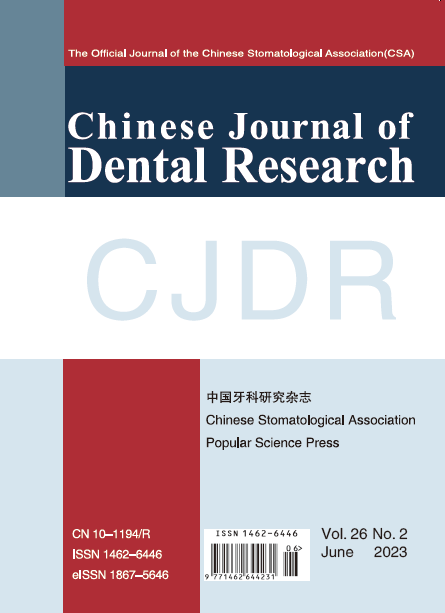Chin J Dent Res 2024;27(1):101–109;doi:10.3290/j.cjdr.b5128671
Hub Genes, Possible Pathways and Predicted Drugs in Hereditary Gingival Fibromatosis by Bioinformatics Analysis
Writer:Rong Xia YANG, Fan SHI, Shu Ning DU, Xin Yu LUO, Wan Qing WANG, Zhi Lu YUAN, Dong CHEN Clicked:
Objective: To explore potential pathogenic processes and possible treatments using unbiased and reliable bioinformatic tools. Methods: Gene expression profiles of control and hepatocyte growth factor (HGF) samples were downloaded from CNP0000995. Analysis of differentially expressed genes (DEGs) was conducted using R software (version 4.2.1, R Foundation, Vienna, Austria). Functional enrichment analyses were performed using the Gene Ontology (GO), Kyoto Encyclopaedia of Genes and Genomes (KEGG) and Gene Set Enrichment Analysis (GSEA) databases, then the proteinprotein interaction (PPI) network was constructed to screen the top 10 hub genes. Finally, five genes related to cell junctions were selected to build gene-miRNA interactions and predict small-molecule drugs. Results: A total of 342 downregulated genes and 188 upregulated genes were detected. Candidate pathways include the extracellular matrix (ECM) receptor interaction pathway, the TGF- signalling pathway and the cell adhesion molecule (CAM) pathway, which were discovered through KEGG and GSEA enrichment studies. GO analyses revealed that these DEGs were significantly enriched in cell adhesion, the adherens junction and focal adhesion. Five hub genes (CDH1, SNAP25, RAC2, APOE and ITGB4) associated with cell adhesion were identified through PPI analysis. Finally, the gene-miRNA regulatory network identified three target miRNAs: hsa-miR-7110-5p, hsa-miR-149-3p and hsa-miR-1207-5p. Based on the gene expression profile, the small-molecule drugs zebularine, ecuronium and prostratin were selected for their demonstrated binding activity when docked with the mentioned molecules. Conclusion: This study offered some novel insights into molecular pathways and identified five hub genes associated with cell adhesion. Based on these hub genes, three potential therapeutic miRNAs and small-molecule drugs were predicted, which are expected to provide guidance for the treatment of patients with HGF. Keywords: CDH1, cell-cell junction, hereditary gingival fibromatosis, MiRNA, small-molecule drugs
Objective: To explore potential pathogenic processes and possible treatments using unbiased and reliable bioinformatic tools.
Methods: Gene expression profiles of control and hepatocyte growth factor (HGF) samples were downloaded from CNP0000995. Analysis of differentially expressed genes (DEGs) was conducted using R software (version 4.2.1, R Foundation, Vienna, Austria). Functional enrichment analyses were performed using the Gene Ontology (GO), Kyoto Encyclopaedia of Genes and Genomes (KEGG) and Gene Set Enrichment Analysis (GSEA) databases, then the proteinprotein interaction (PPI) network was constructed to screen the top 10 hub genes. Finally, five genes related to cell junctions were selected to build gene-miRNA interactions and predict small-molecule drugs.
Results: A total of 342 downregulated genes and 188 upregulated genes were detected. Candidate pathways include the extracellular matrix (ECM) receptor interaction pathway, the TGF-β signalling pathway and the cell adhesion molecule (CAM) pathway, which were discovered through KEGG and GSEA enrichment studies. GO analyses revealed that these DEGs were significantly enriched in cell adhesion, the adherens junction and focal adhesion. Five hub genes (CDH1, SNAP25, RAC2, APOE and ITGB4) associated with cell adhesion were identified through PPI analysis. Finally, the gene-miRNA regulatory network identified three target miRNAs: hsa-miR-7110-5p, hsa-miR-149-3p and hsa-miR-1207-5p. Based on the gene expression profile, the small-molecule drugs zebularine, ecuronium and prostratin were selected for their demonstrated binding activity when docked with the mentioned molecules.
Conclusion: This study offered some novel insights into molecular pathways and identified five hub genes associated with cell adhesion. Based on these hub genes, three potential therapeutic miRNAs and small-molecule drugs were predicted, which are expected to provide guidance for the treatment of patients with HGF.
Keywords: CDH1, cell-cell junction, hereditary gingival fibromatosis, MiRNA, small-molecule drugs
(editor:CJDR) |




